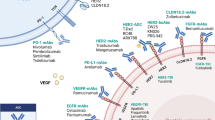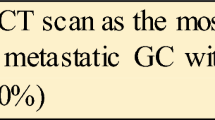Abstract
Objective
Accurate staging is vital for esophageal cancer management. The utility of the American Joint Committee on Cancer (AJCC) staging system 6th edition for esophageal cancer has been questioned for resected patients who receive neoadjuvant chemoradiotherapy (CRT). This study was undertaken to assess the AJCC staging system for patients with esophageal cancer that have received neoadjuvant CRT and to identify clinicopathological variables that predict survival.
Methods
Review of a prospective esophageal cancer database was undertaken for patients that received neoadjuvant CRT and resection. Primary tumor response was defined as major (≤10% residual tumor cells) or minor (>10% residual tumor cells). Cox regression and concordance analyses were used to determine prognostic factors. Median follow-up was 61 months.
Results
Of 131 patients with invasive cancer, there were 40/131 (31%) with squamous cell carcinoma (SCC) and 88/131 (65%) with adenocarcinoma. The procedure-related mortality rate was 3.8%. Median survival was 33 months. A major response was demonstrated by 79/131 (60%) patients. Survival analyses found that the AJCC 6th edition was unable to discriminate between stages 0, I, and IIa or stages IIb and III. Multivariate survival analyses found age, pretreatment tumor length >6 cm, positive lymph nodes, and a major tumor response were independent prognostic factors. These data were used to derive a new staging system that had improved discrimination of stage groups over the current AJCC system.
Conclusion
The current AJCC staging system for esophageal cancer is inadequate for patients that receive neoadjuvant CRT. Refinement of the AJCC staging system should include primary tumor response for patients receiving neoadjuvant CRT.



Similar content being viewed by others
References
Lerut T, Coosemans W, Decker G, et al. Extended surgery for cancer of the esophagus and gastroesophageal junction. J Surg Res 2004;117:58–63.
Griffin SM, Wayman J. Sub-total oesophagectomy with 2 field lymphadenectomy. Minerva Chir 2002; 57:753–66.
Chu KM, Law SY, Fok M, et al. A prospective randomized comparison of transhiatal and transthoracic resection for lower-third esophageal carcinoma. Am J Surg 1997; 174:320–4.
Hulscher JB, van Sandick JW, de Boer AG, et al. Extended transthoracic resection compared with limited transhiatal resection for adenocarcinoma of the esophagus. N Engl J Med 2002; 347:1662–9.
Macdonald JS, Smalley SR, Benedetti J, et al. Chemoradiotherapy after surgery compared with surgery alone for adenocarcinoma of the stomach or gastroesophageal junction. N Engl J Med 2001; 345:725–30.
Medical Research Council Oesophageal Cancer Working Group. Surgical resection with or without preoperative chemotherapy in oesophageal cancer: a randomised controlled trial. Lancet 2002; 359:1727–33
Cunningham D, Allum WH, Stenning SP, et al. Perioperative chemotherapy versus surgery alone for resectable gastroesophageal cancer. N Engl J Med 2006; 355:11–20.
Kelsen DP, Ginsberg R, Pajak TF, et al. Chemotherapy followed by surgery compared with surgery alone for localized esophageal cancer. N Engl J Med 1998; 339:1979–84
Walsh TN, Noonan N, Hollywood D, et al. A comparison of multimodal therapy and surgery for esophageal adenocarcinoma. N Engl J Med 1996; 335:462–7.
Burmeister BH, Smithers BM, Gebski V, et al. Surgery alone versus chemoradiotherapy followed by surgery for resectable cancer of the oesophagus: a randomised controlled phase III trial. Lancet Oncol 2006; 6:659–68.
Gebski V, Burmeister B, Smithers BM, et al. Survival benefits from neoadjuvant chemoradiotherapy or chemotherapy in oesophageal carcinoma: a meta-analysis. Lancet Oncol 2007; 8:226–34.
Stahl M, Stuschke M, Lehmann N, et al. Chemoradiation with and without surgery in patients with locally advanced squamous cell carcinoma of the esophagus. J Clin Oncol 2005; 23:2310–7.
Brucher BL, Becker K, Lordick F, et al. The clinical impact of histopathologic response assessment by residual tumor cell quantification in esophageal squamous cell carcinomas. Cancer 2006; 106:2119–27.
Mandard AM, Dalibard F, Mandard JC, et al. Pathologic assessment of tumor regression after preoperative chemoradiotherapy of esophageal carcinoma. Clinicopathologic correlations. Cancer 1994; 73:2680–6.
Swisher SG, Hofstetter W, Wu TT, et al. Proposed revision of the esophageal cancer staging system to accommodate pathologic response (pP) following preoperative chemoradiation (CRT). Ann Surg 2005; 241:810–7.
Weber WA, Ott K, Becker K, et al. Prediction of response to preoperative chemotherapy in adenocarcinomas of the esophagogastric junction by metabolic imaging. J Clin Oncol 2001; 19:3058–65.
Rizk NP, Venkatraman E, Bains MS, et al. American Joint Committee on Cancer staging system does not accurately predict survival in patients receiving multimodality therapy for esophageal adenocarcinoma. J Clin Oncol 2007; 25:507–12.
Swisher SG, Hofstetter W, Wu TT, et al. Proposed revision of the esophageal cancer staging system to accommodate pathologic response (pP) following preoperative chemoradiation (CRT). Ann Surg 2005; 241:810–7.
Schneider PM, Baldus SE, Metzger R, et al. Histomorphologic tumor regression and lymph node metastases determine prognosis following neoadjuvant radiochemotherapy for esophageal cancer: implications for response classification. Ann Surg 2005; 242:684–92.
Green FL, Page DL, Fleming ID, et al., eds. AJCC Cancer Staging Manual, 6th edition. Springer-Verlag, New York, NY, 2002:111–9
Siewert JR, Feith M, Werner M, et al. Adenocarcinoma of the esophagogastric junction: results of surgical therapy based on anatomical/topographic classification in 1,002 consecutive patients. Ann Surg 2000; 232:353–61.
Suntharalingam M, Haas ML, Sonett JR, et al. Accurate lymph node assessment prior to trimodality therapy for esophageal carcinoma. Cancer J 2001; 7:509–15.
Smithers BM, Gotley DC, Martin I, et al. Comparison of the outcomes between open and minimally invasive esophagectomy. Ann Surg 2007; 245:232–40.
Chirieac LR, Swisher SG, Ajani JA, et al. Posttherapy pathologic stage predicts survival in patients with esophageal carcinoma receiving preoperative chemoradiation. Cancer 2005; 103:1347–55.
Gonen M, Heller G. Concordance probability and discriminatory power in proportional hazards regression. Biometrika 2005; 92:965–70.
Walsh TN, Noonan N, Hollywood D, et al. A comparison of multimodal therapy and surgery for esophageal adenocarcinoma. N Engl J Med 1996; 335:462–7.
Swisher SG, Erasmus J, Maish M, et al. 2-Fluoro-2-deoxy-D-glucose positron emission tomography imaging is predictive of pathologic response and survival after preoperative chemoradiation in patients with esophageal carcinoma. Cancer 2004; 101:1776–85.
Swisher SG, Maish M, Erasmus JJ, et al. Utility of PET, CT, and EUS to identify pathologic responders in esophageal cancer. Ann Thorac Surg 2004; 78:1152–60.
Rohatgi PR, Swisher SG, Correa AM, et al. Failure patterns correlate with the proportion of residual carcinoma after preoperative chemoradiotherapy for carcinoma of the esophagus. Cancer 2005; 104:1349–55.
Lee JL, Park SI, Kim SB, et al. A single institutional phase III trial of preoperative chemotherapy with hyperfractionation radiotherapy plus surgery versus surgery alone for resectable esophageal squamous cell carcinoma. Ann Oncol 2004; 15:947–54.
Donington JS, Miller DL, Allen MS, et al. Tumor response to induction chemoradiation: influence on survival after esophagectomy. Eur J Cardiothorac Surg 2003; 24:631–6.
Torres C, Turner JR, Wang HH, et al. Pathologic prognostic factors in Barrett’s associated adenocarcinoma: a follow-up study of 96 patients. Cancer 1999; 85:520–8.
Swanson SJ, Batirel HF, Bueno R, et al. Transthoracic esophagectomy with radical mediastinal and abdominal lymph node dissection and cervical esophagogastrostomy for esophageal carcinoma. Ann Thorac Surg 2001; 72:1918–24.
Gu Y, Swisher SG, Ajani JA, et al. The number of lymph nodes with metastasis predicts survival in patients with esophageal or esophagogastric junction adenocarcinoma who receive preoperative chemoradiation. Cancer 2006; 106:1017–25.
Eloubeidi MA, Desmond R, Arguedas MR, et al. Prognostic factors for the survival of patients with esophageal carcinoma in the U.S.: the importance of tumor length and lymph node status. Cancer 2002; 95:1434–43.
Griffiths EA, Brummell Z, Gorthi G, et al. Tumor length as a prognostic factor in esophageal malignancy: univariate and multivariate survival analyses. J Surg Oncol 2006; 93:258–67.
Beahrs OH, Meyers MH, eds. Manual for Staging of Cancer. JB Lippincott, Philadelphia, PA, 1983:61–6
Sabel MS, Smith JL, Nava HR, et al. Esophageal resection for carcinoma in patients older than 70 years. Ann Surg Oncol 2002; 9:210–4.
Jougon JB, Ballester M, Duffy J, et al. Esophagectomy for cancer in the patient aged 70 years and older. Ann Thorac Surg 1997; 63:1423–7.
Moskovitz AH, Rizk NP, Venkatraman E, et al. Mortality increases for octogenarians undergoing esophagogastrectomy for esophageal cancer. Ann Thorac Surg 2006; 82:2031–6.
Blazeby JM, Alderson D, Farndon JR. Quality of life in patients with oesophageal cancer. Recent Results Cancer Res 2000; 155:193–204.
Acknowledgements
The authors would like to thank Dr Andrew Clouston, Dr Ian Martin, Dr Jennifer Harvey, and Dr Euan Walpole for their clinical contribution to the data presented in this study.
Author information
Authors and Affiliations
Corresponding author
Rights and permissions
About this article
Cite this article
Barbour, A.P., Jones, M., Gonen, M. et al. Refining Esophageal Cancer Staging After Neoadjuvant Therapy: Importance of Treatment Response. Ann Surg Oncol 15, 2894–2902 (2008). https://doi.org/10.1245/s10434-008-0084-y
Received:
Revised:
Accepted:
Published:
Issue Date:
DOI: https://doi.org/10.1245/s10434-008-0084-y




